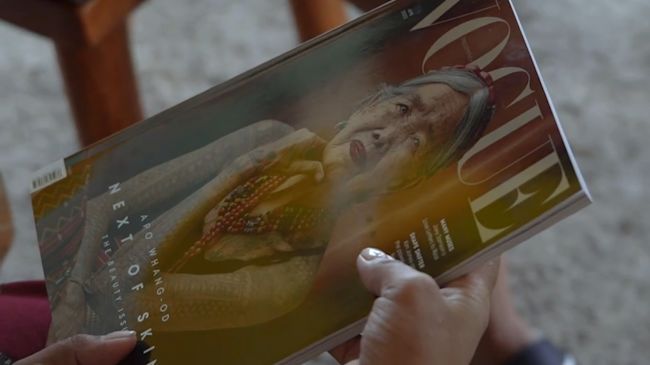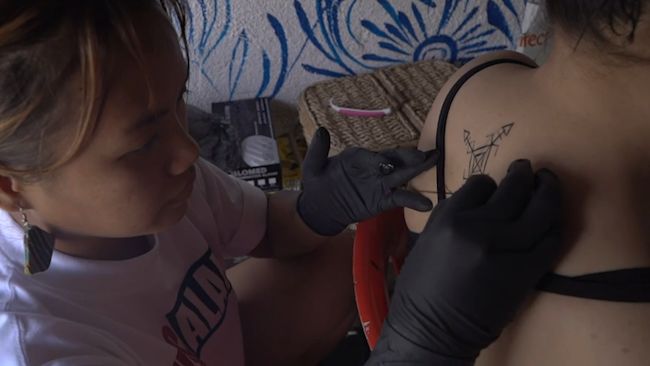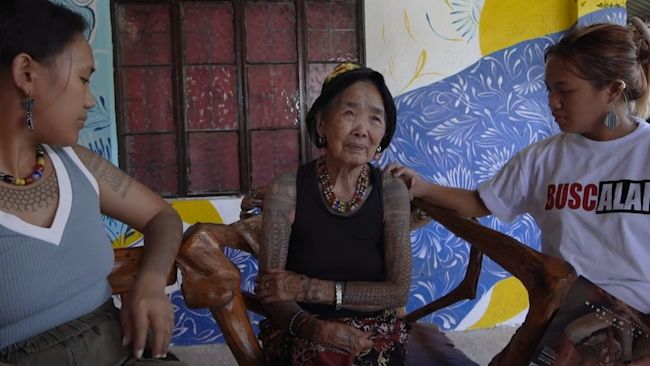Monday 26 June 2023

AT 106, Whang-Od is thought to be the oldest female tattoo artist in the world.
Credit: ITV News
Perched on a cliffside, high in the Cordillera mountains is Buscalan village. Only accessible by foot, it may have remained largely cut off from the rest of the world if not for one remarkable resident.
At 2016-years-old, Whang-Od is thought to be the oldest female tattoo artist in the world.
Taught by her father, she has been heralded as the last mambabatok - a traditional Kalinga tattooist - of her generation.
Using just a bamboo stick, a thorn from a pomelo tree, water and coal, her tattoos were earned for bravery by the Indigenous male Butbut warriors.
Perched on a cliffside, high in the Cordillera mountains is Buscalan village. Only accessible by foot, it may have remained largely cut off from the rest of the world if not for one remarkable resident.
At 2016-years-old, Whang-Od is thought to be the oldest female tattoo artist in the world.
Taught by her father, she has been heralded as the last mambabatok - a traditional Kalinga tattooist - of her generation.
Using just a bamboo stick, a thorn from a pomelo tree, water and coal, her tattoos were earned for bravery by the Indigenous male Butbut warriors.

Whang-Od appeared on the cover of Vogue back in April, making her the oldest person to ever feature on the front cover of the magazine.
Credit: ITV News
In April, she became the oldest ever Vogue cover star, propelling her to international fame and prompting to people travelling from all over the world to get a tattoo from her.
While she is no longer able to complete the more intricate markings of her Kalinga tribe, people still come to her to receive the three dots, which represent Whang-Od and her two grandnieces, that have become her new signature.
An art that can only be passed down to blood relatives, Whang-Od has been training her grandnieces Elyang Wigan and Grace Palicas for years.
In April, she became the oldest ever Vogue cover star, propelling her to international fame and prompting to people travelling from all over the world to get a tattoo from her.
While she is no longer able to complete the more intricate markings of her Kalinga tribe, people still come to her to receive the three dots, which represent Whang-Od and her two grandnieces, that have become her new signature.
An art that can only be passed down to blood relatives, Whang-Od has been training her grandnieces Elyang Wigan and Grace Palicas for years.

Whang-Od's grandnieces have been selected as the next generation of Kalinga tribe tattooists.
Credit: ITV News
The pair now take on the bigger, more intricate tattoos that Whang-Od's failing eyesight prevent her from doing.
All of the tattoos have traditional meanings, but these days they are mostly chosen for style preference and not significance.
Her own body could be described as a work of art, telling the story of her life, work and even some former romances
The pair now take on the bigger, more intricate tattoos that Whang-Od's failing eyesight prevent her from doing.
All of the tattoos have traditional meanings, but these days they are mostly chosen for style preference and not significance.
Her own body could be described as a work of art, telling the story of her life, work and even some former romances
.

Whang-Od's own tattoos represents stories of her life, work, and even some former romances.
Credit: ITV News
This tattooing tradition was mostly lost as Filipinos were converted to Christianity during the Spanish colonial era but it survived in more remote areas of the Philippines.
Today, it is a highly endangered tradition. The hand-tapped tattoos were earned by indigenous warriors.
And for women, the tattoos were considered an aesthetic accessory and ritualistically important. These days, the performance of rituals is altogether left out of the tattoo session, although they can be done if requested, especially upon the completion of a large, multi-day tattoo.
This tattooing tradition was mostly lost as Filipinos were converted to Christianity during the Spanish colonial era but it survived in more remote areas of the Philippines.
Today, it is a highly endangered tradition. The hand-tapped tattoos were earned by indigenous warriors.
And for women, the tattoos were considered an aesthetic accessory and ritualistically important. These days, the performance of rituals is altogether left out of the tattoo session, although they can be done if requested, especially upon the completion of a large, multi-day tattoo.
No comments:
Post a Comment